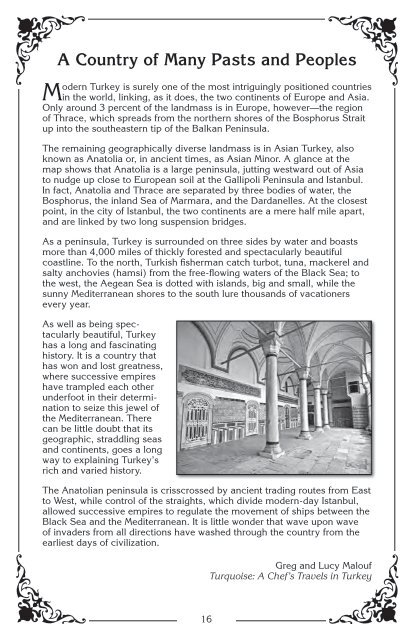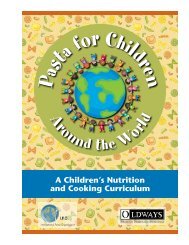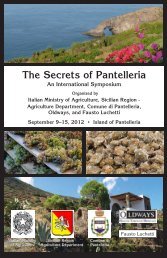Turkey's Culinary Heritage - Oldways
Turkey's Culinary Heritage - Oldways
Turkey's Culinary Heritage - Oldways
You also want an ePaper? Increase the reach of your titles
YUMPU automatically turns print PDFs into web optimized ePapers that Google loves.
A Country of Many Pasts and Peoples<br />
Modern Turkey is surely one of the most intriguingly positioned countries<br />
in the world, linking, as it does, the two continents of Europe and Asia.<br />
Only around 3 percent of the landmass is in Europe, however—the region<br />
of Thrace, which spreads from the northern shores of the Bosphorus Strait<br />
up into the southeastern tip of the Balkan Peninsula.<br />
The remaining geographically diverse landmass is in Asian Turkey, also<br />
known as Anatolia or, in ancient times, as Asian Minor. A glance at the<br />
map shows that Anatolia is a large peninsula, jutting westward out of Asia<br />
to nudge up close to European soil at the Gallipoli Peninsula and Istanbul.<br />
In fact, Anatolia and Thrace are separated by three bodies of water, the<br />
Bosphorus, the inland Sea of Marmara, and the Dardanelles. At the closest<br />
point, in the city of Istanbul, the two continents are a mere half mile apart,<br />
and are linked by two long suspension bridges.<br />
As a peninsula, Turkey is surrounded on three sides by water and boasts<br />
more than 4,000 miles of thickly forested and spectacularly beautiful<br />
coastline. To the north, Turkish fisherman catch turbot, tuna, mackerel and<br />
salty anchovies (hamsi) from the free-flowing waters of the Black Sea; to<br />
the west, the Aegean Sea is dotted with islands, big and small, while the<br />
sunny Mediterranean shores to the south lure thousands of vacationers<br />
every year.<br />
As well as being spectacularly<br />
beautiful, Turkey<br />
has a long and fascinating<br />
history. It is a country that<br />
has won and lost greatness,<br />
where successive empires<br />
have trampled each other<br />
underfoot in their determination<br />
to seize this jewel of<br />
the Mediterranean. There<br />
can be little doubt that its<br />
geographic, straddling seas<br />
and continents, goes a long<br />
way to explaining Turkey’s<br />
rich and varied history.<br />
The Anatolian peninsula is crisscrossed by ancient trading routes from East<br />
to West, while control of the straights, which divide modern-day Istanbul,<br />
allowed successive empires to regulate the movement of ships between the<br />
Black Sea and the Mediterranean. It is little wonder that wave upon wave<br />
of invaders from all directions have washed through the country from the<br />
earliest days of civilization.<br />
Greg and Lucy Malouf<br />
Turquoise: A Chef’s Travels in Turkey<br />
The Food<br />
We found that there’s a definite tendency<br />
to divide Turkish food into<br />
two camps: Ottoman and Anatolian. In<br />
other words, a distinction between the<br />
food of the urban rich and the food of the<br />
rural poor. The reality, of course, is far<br />
more complicated. Turkish cooking today<br />
is an interweaving of many different but<br />
complimentary strands that together<br />
create a gorgeous and vibrant culinary<br />
tapestry.<br />
Both rural Anatolian and sophisticated<br />
Ottoman cuisines are a legacy of the<br />
country’s rich and varied history, the<br />
complex interchange and cross-fertilization<br />
of culinary traditions and influences<br />
that have washed through the country down the centuries. Their ingredients<br />
and recipes are drawn from such diverse parts of the world as Central and<br />
Far East Asia, Persia, Arabia, the Balkans and the Mediterranean.<br />
Growers, sellers and consumers all share a respect for the food they eat.<br />
Turks are fussy about the quality of their food and demand that it be the<br />
best, the freshest, the most intensely flavored. This means that produce<br />
markets are almost always limited to what is seasonally available—you<br />
won’t find expensive strawberries in Turkish market stalls in the middle of<br />
winter.<br />
And when it comes to food preparation, the same respectful approach applies.<br />
As one Turkish food writer told us: Turkish food is not about experimentation,<br />
it is about technique—about cooking a particular dish in the<br />
time-honored way, in the very best way you can.<br />
While Turks may well be determined to preserve and protect their food<br />
traditions, it seems that it is not entirely at the expense of innovation.<br />
The winds of change do seem to be blowing—or at least wafting gently—<br />
through the country’s food scene. In recent years, for instance, a small<br />
number of passionate chefs have been introducing Istanbullus to the pleasures<br />
of rural “peasant” food, while still others have taken the first tentative<br />
steps toward experimenting with classic dishes and ingredients. There will<br />
always be purists who are horrified by this sort of “messing around” with<br />
traditional dishes, of course, but we are all for progress and evolution in the<br />
kitchen. And, in the end, perhaps the most important culinary legacy that<br />
the Ottomans left to modern-day Turkey is the importance of taking risks<br />
and a willingness to experiment. After all, has it not been demonstrated that<br />
out of such boldness and creativity, greatness has come?<br />
16 17<br />
Greg and Lucy Malouf<br />
Turquoise: A Chef’s Travels in Turkey




